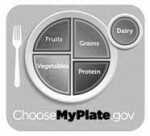- January is 'Kansas Radon Action' month (1/15/13)
- Advice on making your New Year's resolutions stick (12/26/12)
- Tips for a safe and healthy holiday season (12/4/12)
- Prepare now to enjoy the holiday season (11/13/12)
- Food safety tips make fall picnics, tailgates winners (10/2/12)
- Make a grab-and-go box to prepare for disasters (9/11/12)
- Family time around the dinner table is important (8/21/12)
Introducing MyPlate, the new food icon
Tuesday, June 14, 2011

Recently, the United States Department of Agriculture (USDA) unveiled a new food icon to help consumers make healthier food choices. MyPlate is a replacement for the MyPyramid icon and reflects the recommendations of the 2010 Dietary Guidelines for Americans.
We know that what we eat does matter. MyPlate is a visual reminder to make healthy food choices when choosing your next meal. MyPlate can help prioritize food choices by reminding us to fill half of our plate with fruits and vegetables. It also reminds us of the other important food groups for a well-balanced meal -- whole grains, lean proteins and lowfat dairy.
In addition to the icon being a plate instead of a pyramid, there are some other changes. The former "meat and beans group" is now the "protein group" and the "milk group" is the "dairy group."
Protein comes from many sources in addition to meat and dry beans. Those sources include eggs, nut butter, nuts and tofu. In addition to milk, the dairy group includes yogurt, cheese, fortified soy beverages and cheese.
Three key consumer messages the dietary guidelines and MyPlate address are 1) balancing calories, 2) foods to increase and 3) foods to reduce.
1.) Balancing calories. Enjoy your food, but eat less. 100 extra calories a day can add 10 extra pounds of weight in a year. Eat until you are satisfied, not full. Remember that it takes about 20 minutes for the stomach to tell the brain it is full.
Avoiding oversized portions is key to balancing calories. The bigger the portion served, the more people tend to eat. As Yogi Berra said, "You better cut the pizza in four pieces, because I'm not hungry enough to eat six."
Balancing calories is also about getting regular physical activity. Adults need at least 2 hours and 30 minutes of moderate-intensity activity or 1 hour and 15 minutes of vigorous-intensity activity each week. Children need 60 minutes of activity every day.
2.) Foods to increase. Filling a plate half full of fruits and vegetables, making half your grains whole grains and switching to fat-free or low-fat (1 percent) milk are encouraged. These are foods that provide lots of nutrients for the calories consumed -- they are said to be nutrient-dense. Preparing such foods with added solid fats, sugars or salt can change their status.
For example, unsweetened applesauce (105 calories) is more nutrient-dense than sweetened applesauce (173 calories). A baked chicken breast (138 calories) is more nutrient-dense than breaded fried chicken strips (246 calories). Fat-free milk (85 calories) is more nutrient-dense than whole milk (165 calories) or 2 percent milk (125 calories).
3.) Foods to decrease. Sodium and sugary drinks are foods which most people need to reduce in their diets. Compare sodium in foods like soup, bread and frozen meals and choose the foods with lower numbers. Avoid adding salt as you cook and at the table. Eat more fresh foods and frozen veggies.
People age 2 and older should consume less than 2,300 milligrams of sodium daily. For African Americans, adults 51 and older, and people with high blood pressure, diabetes or chronic kidney disease, the recommendation is 1,500 milligrams daily.
A website that has a wealth of consumer information, tools and materials about healthy eating is www.ChooseMyPlate.gov. Interactive tools allow a person to create a customized daily food plan, analyze a diet and get weight loss information. Check it out and let MyPlate become your plate.
Editor's Note: Ann Ludlum is a K-State Research and Extension family and consumer sciences and 4-H extension agent assigned to Bourbon County. She may be reached at (620) 223-3720 or aludlum@ksu.edu.

